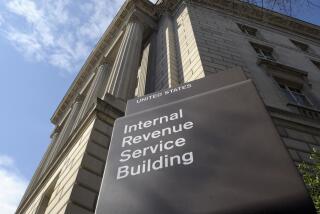Your Tax Return Is Filed; Time to Look at Next Year
- Share via
It may be the last thing you want to think about after dispensing with your annual tax chores, but it’s time to do a little tax planning for next year’s filing season.
“Whenever people finish filing their returns, they put them aside and don’t think about taxes for another year,” said Bob Scharin, editor of Warren, Gorham & Lamont’s Practical Tax Strategies. “But right after you’ve done your return is the best time to try to reduce your tax for next year.”
A completed tax return practically bristles with planning ideas, Scharin said. Simple things, such as looking at your marginal tax bracket, will tell you whether it’s wise to consider tax-favored investments--municipal bonds, for instance.
Doing a thorough review now can save thousands of dollars in tax later.
That’s partly because the Tax Code is riddled with income thresholds that bar higher-income filers from taking full advantage of credits. Careful planning can allow many taxpayers to manage the income level that matters--adjusted gross income--to get more of these income-contingent breaks.
Meanwhile, other individuals may find that either their tax bracket or their investment strategies warrant changes that could prove rewarding--at least for tax purposes.
You can start the review yourself, even if you use a professional to prepare your return. Here’s how.
Start With the Kids
For the estimated 50 million taxpayers with children, a place to start is with the child tax credit, one of 20 income-contingent tax breaks for individual filers. Are you losing part of this break because of how much you earn? Here’s how to find out:
Multiply by $600 the number of dependent children younger than 17 that you listed on the 1040 tax form you filed this year. Compare that number with the figure on line 48 of the form--the child tax credit.
If the child tax credit you claimed is less than the result you calculated, your credit amount was reduced because your income exceeded a certain threshold. Specifically, you lose $50 for each $1,000 that your adjusted gross income exceeds $55,000 when single, or $110,000 when married, filing jointly.
Your goal is to find “before-the-line” deductions--these are expenses that are deducted before adjusted gross income is calculated--that you can take advantage of to lower adjusted growth income (that’s the figure on line 33 of your 1040 form).
Contributions to 401(k), 403(b) and 457 retirement plans, alimony payments, deductible student loan interest and certain work expenses are likely candidates for before-the-line deductions. Make sure you’ve deducted all you’re entitled to in each of these areas. If you aren’t contributing the maximum amount to a retirement plan, for example, you’d be wise to boost your savings level.
Education Costs
If you’re paying expenses for a member of your household to attend college in the next few years, and your adjusted gross income is a little more than $41,000 if single or $82,000 if married, revisit the before-the-line deductions. Those income thresholds determine whether you can claim either the Hope tax credit, which can reduce your income tax by as much as $1,500 annually, or the Lifetime Learning credit, which can reduce your tax by as much as $1,000 a year.
Each $1,000 in income above the threshold--$2,000 for married couples--causes the taxpayer to lose 10% of the applicable education tax credit.
The AMT
Is there a figure listed on line 41 of your 1040 form? If so, you’ve been caught by the alternative minimum tax.
The AMT kicks in for taxpayers who have unusually high deductions for state taxes, medical expenses or large profits on investments. If you regularly trigger the AMT, your best bet is to seek professional tax advice about better managing certain types of income and expenses.
Tax Bracket
One last item to check on your 1040: line 39, which lists your taxable income. Taxable income determines your tax bracket, which is the tax rate that applies to your last dollar of income. (This also is known as your marginal tax rate.) There are six federal income tax brackets this year, ranging 10% to 38.6%.
The higher your tax bracket, the more likely you are to benefit from tax-deferred or tax-efficient investments.
Investment Gains, Losses
Now that you know your tax bracket, turn to Schedule D of your tax return, where you listed profits and losses on your investments.
If you did little trading last year but still generated substantial capital gains, it’s possible that you’re invested in mutual funds that pay little attention to taxes. It may make sense--both to save taxes and boost your total return--to look for funds that generate fewer taxable gains.
Fortunately, funds now are reporting after-tax returns in their prospectuses, so searching for a tax-efficient fund is easier than ever.
If the gains in your portfolio came from active trading--an activity you like and intend to continue--you may want to look at variable annuities.
Annuities allow people who already have invested the maximum amount possible in tax-deferred retirement plans (such as a 401(k) or individual retirement account) to save additional money on a tax-deferred basis.
The costs associated with the annuity structure--it is a form of insurance policy--makes them inadvisable for most investors. But investors in high tax brackets who trade frequently may save taxes by putting those investments in an annuity.
Did you have more capital losses than you could legally claim as deductions on this year’s tax return? If so, those capital loss “carry-forwards” can be used to shelter profits on the sale of other securities--maybe those tax-inefficient funds you were going to sell.
Meanwhile, people who invest in income-oriented securities, such as bonds and real estate investment trusts, may want to consider whether their tax bracket is high enough to suggest investing in tax-free municipal bonds instead.
How can you tell? Look at what is known as the taxable equivalent yield, which is what you’d have to earn on a taxable investment to beat the tax-free return on a municipal bond. For taxpayers in high marginal brackets, the taxable equivalent yield on a municipal bond is sometimes significantly greater than comparable taxable yields.
To calculate your taxable equivalent yield, divide the municipal bond’s tax-free yield by the inverse of your combined state and federal tax rate.
For example, if you pay 38.6% in federal tax and 5% in state tax, your combined rate would be 43.6%. The inverse of 43.6% would be 56.4% (1 minus 0.436), or 0.564.
Thus, on a municipal bond with a tax-free yield of 5%, your taxable equivalent yield would be 8.87%, or 5 divided by 0.564. That’s considerably better than the current taxable yield on the benchmark 10-year Treasury note, which is about 5.20%
*
Times staff writer Kathy M. Kristof, author of “Investing 101” (Bloomberg Press, 2000), welcomes your comments and suggestions but regrets that she cannot respond individually to letters or phone calls. Write to Personal Finance, Business Section, Los Angeles Times, 202 W. 1st St., Los Angeles, CA 90012, or e-mail kathy.kristof@latimes.com. For past Personal Finance columns visit The Times’ Web site at www.latimes.com/perfin.
(BEGIN TEXT OF INFOBOX)
What’s Your Tax Bracket?
If you’re in a high tax bracket, it’s smart to consider tax-favored investments. Here are the tax brackets for the 2002 tax year for each filing status.
Single filers
$0-$6,000 10.0%
6,001-27,950 15.0
27,951-67,700 27.0
67,701-141,250 30.0
141,251-307,050 35.0
307,051+ 38.6
Head of household
$0-$10,000 10.0%
10,001-37,450 15.0
37,451-96,700 27.0
96,701-156,600 30.0
156,601-307,050 35.0
307,051+ 38.6
Married, filing jointly
$0-$12,000 10.0%
12,001-46,700 15.0
46,701-112,850 27.0
112,851-171,950 30.0
171,951-307,050 35.0
307,050 + 38.6
Source: CCH
More to Read
Inside the business of entertainment
The Wide Shot brings you news, analysis and insights on everything from streaming wars to production — and what it all means for the future.
You may occasionally receive promotional content from the Los Angeles Times.










